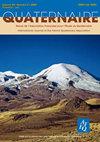The loess-palaeosol sequence of novyi tik: a new middle and upper pleistocene record for volyn’ upland (North-West Ukraine)
IF 1
4区 地球科学
Q4 GEOSCIENCES, MULTIDISCIPLINARY
引用次数: 4
Abstract
The Novyi Tik sequence includes the Middle and Upper Pleistocene loess-palaeosol units of Ukrainian stratigraphy, tentatively correlated with marine isotope stages (MIS) 10 to 1. The site demonstrates the facies diversity of palaeosols and other sediments, as many of its sections are located in sediment traps (palaeogullies). Welded soils are here replaced by well-developed pedocomplexes, which show different phases of soil formation. Three main pedocomplexes have been revealed at Novyi Tik, and tentatively correlated with MIS 5, 7 and 9. Each pedocomplex comprises a lower interglacial forest soil (Luvisol or Retisol) and an upper interstadial steppe or forest-steppe soil (Chernozem, Phaeozem or Cambisol). The upper pedocomplex (MIS 5) is characterised by the largest vertical and lateral facies diversity. Thin loess beds and cryogenic features within the pedocomplexes are indicators of relatively short, dry and cold events. All these units have been studied by several methods, i.e. grain-size analyses, humus content, micromorphology and palynology. These enable reconstructions of numerous environmental changes in the Middle and Late Pleistocene in the study area, particularly evidenced by the evolution of pedogenic processes, vegetation development, and the periodicity of cryogenic events. A split Mammuthus primigenius bone and the oldest Levallois tool known from the Volyn’ Upland and found at Novyi Tik enhance the site’s importance and potential for further research.novyi tik黄土-古土壤序列:沃林高地(乌克兰西北部)中上更新世新记录
Novyi Tik层序包括乌克兰地层的中、上更新世黄土-古土壤单元,初步与海洋同位素阶段(MIS) 10 ~ 1相对应。该遗址显示了古土壤和其他沉积物的相多样性,因为它的许多剖面位于沉积物圈闭(古沟槽)中。这里的焊接土被发育良好的土壤复合体所取代,这些土壤复合体表现出不同的土壤形成阶段。在Novyi Tik发现了三个主要的恋童情结,并初步与MIS 5、7和9相关。每个土壤复合体包括较低的间冰期森林土壤(Luvisol或Retisol)和较高的间冰期草原或森林草原土壤(黑钙土,Phaeozem或Cambisol)。上部杂岩(MIS 5)的垂向和横向相多样性最大。土壤复合体内的薄黄土层和低温特征是相对较短的干冷事件的标志。通过粒度分析、腐殖质含量、微形态学和孢粉学等方法对这些单位进行了研究。这些特征可以重建研究区中、晚更新世的大量环境变化,特别是成土过程的演变、植被的发育和低温事件的周期性。在Novyi Tik发现的劈开的原始猛犸象骨头和Volyn高地已知的最古老的勒瓦卢瓦人工具增强了该遗址的重要性和进一步研究的潜力。
本文章由计算机程序翻译,如有差异,请以英文原文为准。
求助全文
约1分钟内获得全文
求助全文
来源期刊

Quaternaire
地学-地球科学综合
CiteScore
1.70
自引率
0.00%
发文量
18
审稿时长
>12 weeks
期刊介绍:
La revue Quaternaire créée dès 1964 par l"AFEQ sous le nom de Bulletin de l"AFEQ est devenue Quaternaire en 1990. Ce journal scientifique paraît au rythme de quatre numéros par an. La revue publie des numéros d"auteurs (par ordre d"arrivée des manuscrits après acceptation) ou des numéros thématiques sur proposition ou invitation par le comité de rédaction. Les articles (en langue française, anglaise ou allemande) traitant de tous les aspects du Quaternaire sont acceptés. La revue est publiée avec le concours du Centre National de la Recherche Scientifique.
 求助内容:
求助内容: 应助结果提醒方式:
应助结果提醒方式:


